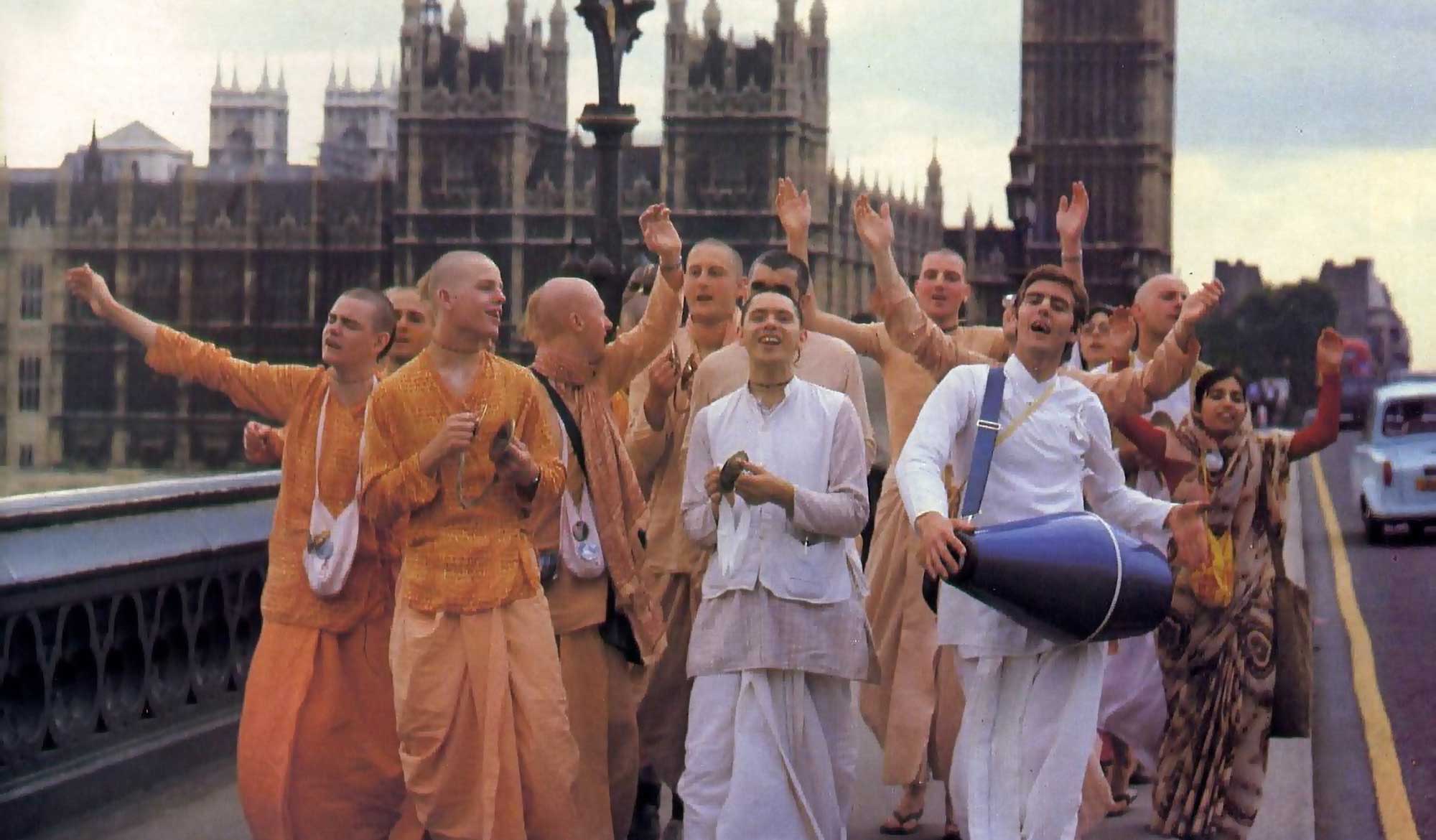Overview
Śrī Śrī Jīva Gosvāmī Prabhu was first published in Sajjana Toṣaṇī, Vol.2 issue 12 in 1885. Before giving a brief biography of Jīva Gosvāmī, Śrīla Bhaktivinoda Ṭhākura discusses the title 'Prabhu' and who should use it. In this biography, the Thakura gives a list of Śrī Jīva's works and mentions his influence on Vallabhācārya.
(translated by Swami B.V. Giri)
* Some people object to calling all these mahātmas as ‘prabhu.’ They claim that no one except for Śrīman Nityānanda and Śrīmad Advaita can be addressed by the word ‘prabhu.’ This is true, but there is no fault with those who refer to a Vaiṣṇava ācārya and bhajanānandī Vaiṣṇavas as prabhu. Those who show bhakti towards the three forms of Guru, Kṛṣṇa and Vaiṣṇava, considering the non-difference in respect to their Vaishnava qualities, is worthy of following. In some ācārya dynasties, the titles ‘Prabhu,’ ‘Ṭhākura,’ ‘Gosvāmi,’ etc, which are used, are not śāstrika, and are titles that are only given by the devotees. All these issues can be debated only in a mālya-candana-sabhā (an assembly where everyone must get a garland and sandalwood paste) and not elsewhere. Those who are true devotees do not argue about all this. It is the selfish, arrogant and vain contenders that make such factions. The result is that they continue to fall down due to their contempt for true bhakti. The Vaiṣṇava alone is our prabhu. Where there is bhakti, there are prabhus. The etiquette observed within dynasties is not a limb of bhakti-tattva. At one time a man told us that no one except Acyutānanda, the son of Śrī Śrī Sītānātha (Advaita) could use the title ‘Gosvāmī’ because Sītānātha himself had rejected his other sons as inimical towards Gaura. Another time, one man claimed that anyone who was not in the seminal line of Śrī Śrī Vīracandra Prabhu could be called a descendent of Nityānanda and that the gosvāmīs of Khaḍadaha should not be called Prabhu. I have heard that the gosvāmīs of Bāghnapaḍa should also not to be referred to as Prabhu, since they are only disciples of Jāhnavī Mātā. We do not wish to hear such arguments. We worship all Vaiṣṇavas as a form of Kṛṣṇa. I must give due respect to the ācārya-vaṁśas. But if they are antagonistic towards Kṛṣṇa, or eager to change their religion, I cannot give them respect simply based upon their family connection. Is it one’s duty to show the etiquette afforded to one of a brāhmaṇa lineage to a Bandyopādhyāya who is a Christian? In the same way, if someone born in a prabhu-santāna (seminal lineage from Nityānanda or Advaita) rejects his dharma, then he can no longer hope to gain the respect showed to that line. Those in the family line of our Nityānanda Prabhu and Advaita Prabhu, and those in the line of the distribution of their potency (disciplic line), are all our prabhus and ācāryas. Some are mantra-gurus and some are śikṣā-gurus.
Upon hearing the name of Śrī Jīva Gosvāmī, a Vaiṣṇava’s heart dances in bliss. Jīva Gosvāmī took birth in Bākulā-Candradvīpa, in the Bharadvāja-gotra descended from Sarvajña Jagad-guru, whose name was the crest-jewel of the brāhmaṇa dynasty and the embodiment of light in his family line. Kumāradeva had many children, amongst whom were Śrī Rūpa, Sanātana and Vallabha – these three are the very life of the Gauḍīya Vaiṣṇavas. Śri Jīva Gosvāmī was the only son of Vallabha.
From his childhood, Śri Jīva Gosvāmī was attracted to Vaiṣṇava dharma. As a child, he used to stay in the village of Rāmakeli near Śrī Rūpa and Sanātana. At the time when Śrī Śrī Mahāprabhu Caitanyadeva, the deliverer of the people of the age of Kali, came to Rāmakeli to accept Rūpa and Sanātana, the childlike Jīva Gosvāmī secretly took darśana of Mahāprabhu’s holy feet. This is mentioned in the book Bhakti-ratnākara. His father, along with Śrī Rūpa Gosvāmī, took darśana of the Lord’s feet in Prayāga, and then returned to the banks of the Gaṅgā. There he disappeared. At that time, Śrī Jīva Gosvāmī was constantly residing in Candradvīpa.
After the disappearance of Śrī Śrī Mahāprabhu, renunciation dawned upon Jīva Gosvāmī. He did not accept a wife. At an early age he had acquired special knowledge in vyākaraṇa (grammar), sāhitya (literature), ālaṅkāra (prose) etc. and went to Śrī Navadvīpa to study tattva-śāstra (philosophical texts). There, the Lord of the life of the Vaiṣṇavas, Prabhu Nityānanda, bestowed special mercy on him, and allowed him to go to Śrī Vṛndāvana-dhāma. Without delay Śrī Jīva travelled to Vṛndāvana.
Arriving in the city of Vārāṇasī, the dhāma of Śrī Mahādeva who is worshippable by all Vaiṣṇavas and those sādhakas who desire liberation, Jīva Gosvāmī met with Śrī Madhusūdana Vācaspati. He stayed there for some time studying nyāya-śāstra and Vedānta philosophy with Vācaspati. In a very short time, Jīva Gosvāmī was considered to be the chief scholar of both nyāya and Vedānta–śāstra in Kāśī-dhāma.
After completing his studies, Jīva traveled to Mathurā-maṇḍala. Arriving there, he surrendered himself at the feet of Śrī Rūpa and Sanātana. Jīva Gosvāmī studied all the bhakti-śāstra with Rūpa. Within a few days, Śrī Jīva Gosvāmī was accepted as the only ācārya in the Gauḍīya sampradāya. From that time on, Śrī Jīva Gosvāmī never left Vṛndāvana-dhāma. During that long period, Śrī Jīva Gosvāmī wrote the following twenty-five books:
Names of the Books Written by Śrī Jīva
1) Hari-nāmāmṛta Vyākaraṇa
2) Sūtra-mālā
3) Dhātu Saṅgraha
4) Kṛṣṇārcana Dīpikā
5) Gopāla Virudāvalī
6) Rasāmṛta-śeṣa
7) Śrī Mādhava Mahotsava
8) Saṅkalpa Kalpavṛkṣa
9) Bhāvārtha-sūcaka Campu
10) A commentary on the Gopāla Tāpanī
11) A commentary on the Brahma-saṁhitā
12) A commentary on the Rasāmṛta
13) A commentary on the Ujjvala Nīlamaṇi
14) A commentary on the Yoga-sārantara
15) Gāyatrī Bhāṣya
16) Kṛṣna-pada-cihna
17) Rādhikā Kara-pada-cihna
18) Śrī Gopāla Campu
19) A commentary on the Bhāgavata called Krama-Sandarbha
20) Tattva Sandarbha
21) Bhagavat Sandarbha
22) Bhakti Sandarbha
23) Paramātma Sandarbha
25) Prīti Sandarabha
In some of the books of Śrī Jīva Gosvāmī the years are mentioned. The Vaiṣṇava-Toṣaṇī was composed by Śrī Sanātana Gosvāmī in 1476 Śakābda (1553 CE). At the behest of Śrī Sanātana, Śrī Jīva wrote a short version of this book in 1504 Śakābda (1581 CE). Śrī Jīva Gosvāmī lived a long life and enhanced the beauty of the holy dhāma for a long time. Even Śrī Kṛṣṇa Dāsa Kavirāja Gosvāmī, Śrīnivāsa Ācārya Prabhu, Śrī Narottama Ṭhākura Mahāśaya and others visited Śrī Jīva and learned from him. The samādhi of Śrī Jīva Gosvāmī still exists in Śrī Vṛndāvana
In Vedānta philosophy, there was no one like Śrī Jīva at that time. It is said that Śrī Vallabha, the ācārya of the Viṣṇu Svāmī sampradāya, showed his book Tattva Dīpa to Śrī Jīva. Śrī Jīva Gosvāmī raised many Vedāntika points to show how the philosophy in the book was unpleasant. Vallabhācārya also corrected many of his books on the advice of Śrī Jīva. The following are some ślokas from Tattva Dīpa composed by Vallabhācārya:
prapañco bhagavat-karyas tad rūpo māyayā’bhavat
tacchaktyā’vidyayā tasya jīva saṁsāra ucyate
saṁsārasya layo muktau prapañcasya na karhicit
kṛṣṇasyātma-ratau tvasya layaḥ sarva-sukhāvahaḥ
(“The material world comprised of five elements is a creation of Bhagavān, and He creates that through māyā. By His avidyā potency, the jīva suffers in saṁsāra. For one who attains the state of jīvan-mukti, saṁsāra dissolves, but saṁsāra itself never actually dissolves. The jīva dissolves into his own attraction towards Kṛṣna which is all-blissful.”)
And also:
tad icchā mātra tasmād brahma bhūtāṁśa-cetanāḥ
srṣṭhādau nirgatāḥ sarve nirākārāntad icchayā
visphūliṅgā ivāgnesta sadaṁśe na jaḍā api
ānandāṁśa-svarūpeṇa sarvāntaryāmi-rūpinaḥ
(“Simply by the desire of the Lord, those aṁśas from Him that are conscious appeared before creation without a material form. These aṁśas appear like sparks from a fire and are immaterial. Within all of them, the Lord resides as the antaryāmi which has ānanda as a part of it.”)
Those Vaiṣṇavas that are expert in tattva have noticed the intervention of Śrī Jīva in consideration of the meaning of some of these ślokas. We consider that Jīva Gosvāmī is a scholar and a personality learned in Vedānta who is equal to Śrī Rāmānuja. Jīva’s Ṣaṭ Sandarbha is a special jewel in the world of books. If someone properly understands the Ṣaṭ Sandarbha, no conclusion concerning Vedānta remains unknown to him.













